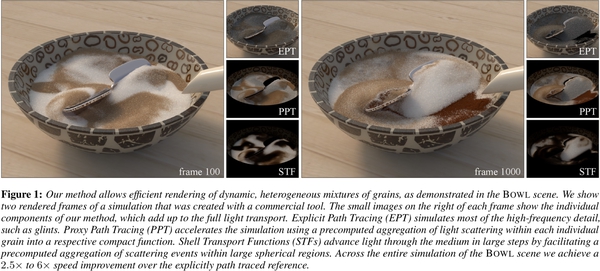Efficient Rendering of Heterogeneous Poly-Disperse Granular Media
We address the challenge of efficiently rendering massive assemblies of grains within a forward path-tracing framework.
November 11, 2016
ACM SIGGRAPH Asia 2016
Authors
Thomas Müller (Disney Research/ETH Joint PhD)
Marios Papas (Disney Research)
Markus Gross (Disney Research/ETH Zurich)
Wojciech Jarosz (Dartmouth College)
Jan Novak (Disney Research)
Efficient Rendering of Heterogeneous Poly-Disperse Granular Media
Previous approaches exist for accelerating high-order scattering for a limited, and static, set of granular materials, often requiring scene-dependent precomputation.
We significantly expand the admissible regime of granular materials by considering heterogeneous and dynamic granular mixtures with spatially varying grain concentrations, pack rates, and sizes. Our method supports both procedurally generated grain assemblies and dynamic assemblies authored in off-the-shelf particle simulation tools.
The key to our speedup lies in two complementary aggregate scattering approximations which we introduced to jointly accelerate construction of short and long light paths.
For low-order scattering, we accelerate path construction using novel grain scattering distribution functions (GSDF) which aggregate intra-grain light transport while retaining important grain-level structure.
For high-order scattering, we extend prior work on shell transport functions (STF) to support dynamic, heterogeneous mixtures of grains with varying sizes. We do this without a scene-dependent precomputation and show how STFs can also be used to accelerate light transport in arbitrary continuous heterogeneous media.
Our multi-scale rendering automatically minimizes the usage of explicit path tracing to only the first grain along the light path, or can avoid it completely, when appropriate, by switching to our aggregate transport approximations.
We demonstrate our technique on animated scenes containing mixtures of various types and concentrations of grains that could not be previously rendered efficiently. We also compare our method against previous work on a simpler class of granular assemblies, reporting significant computation and memory savings, often yielding higher accuracy results.

